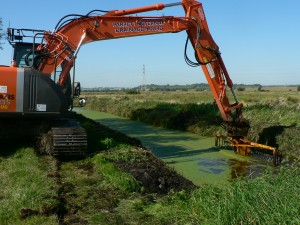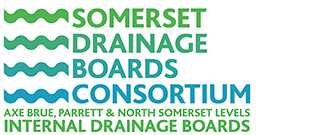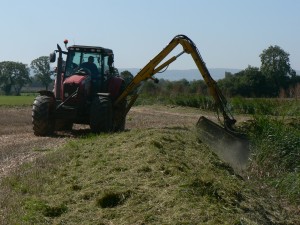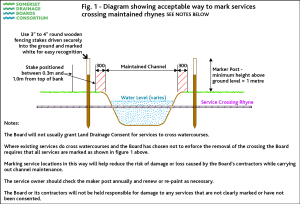The Consortium Boards manage water levels and maintains a watercourse network system to provide irrigation, drainage and flood protection, irrigation and environmental enhancement.
These maintained watercourses are locally known as Viewed Rhynes. The lengths of watercourse maintained by each Board are shown below.
- Axe Brue 601 km
- Parrett 584 km
- North Somerset Levels 191 km
The work involves the flailing of the bank(s) to provide good viability for the machine operators and to manage scrub/trees at the edge of the channel, this work is undertaken by tractor/flail or a self-propelled flail unit. Tracked/wheeled excavators will follow the flail equipment (normally within two weeks) to undertake cutting and removal of vegetation from within the channel to ensure a clear passage for water. The cut vegetation/arisings is routinely deposited on the land adjacent to the watercourse where it will allowed to decompose naturally or may be removed by the riparian owner(s).
The annual routine maintenance of the Viewed Rhynes runs from May to February each year, we maintain 1492km of watercourses across the Boards’ areas, please click here to see maps showing estimated maintenance timing.
An unimpeded machine access is required to enable contractors to undertake this important maintenance work. Please ensure that you do not place any obstructions within 9m from the top of the bank of the rhyne and inform us of any locked access gates.
The maintenance work is undertaken by IDB approved contractors who are employed on a three year contract.
MAIZE (Arable Crops): Growing of Maize is on the increase and where crops are planted up to the edge of the watercourse machine access becomes difficult and unsafe, at these locations it may not be possible to undertake the routine maintenance at the scheduled time.
Where suitable access has NOT been provided the following options may be implemented:
- Track through/flailing of crops to gain access to the viewed rhyne and undertake
 the maintenance as programmed.
the maintenance as programmed. - Not undertake the maintenance and return at a later date to complete works: additional costs incurred and return trips may not always be possible due to contractor availability and/or budget constraints
- Where sections of viewed rhynes are left unmaintained this may reduce conveyance and increase flood risk to properties and business within an area.
- Where maintenance is obstructed, we may require the land owner to undertake the maintenance work themselves.
cleaning along Sedgemoor Drove, Chedzoy
Please be considerate and provide tracking routes to and from the viewed rhynes and leave a minimum 4m maintenance strip that enables our contractors to undertake maintenance safely and efficiently on all viewed rhynes.
If you are planning on planting crops adjacent to viewed rhynes but are uncertain of our access requirements please contact the Board’s Office on the number provided to arrange for your local Area Supervisor to contact you to discuss access requirements within your area.
RIPARIAN WATERCOURSES/CULVERTED WATERCOURSES: the IDBs have jurisdiction over all watercourses within each Board’s area, the annual maintenance of the viewed rhyne system is undertaken using permissive powers within the Land Drainage Act 1991. As a riparian owner you have a legal obligation to ensure your watercourse(s) are maintained to a sufficient standard so that the free flow of water is not impeded. The Board(s) may, when required, instruct riparian owners to undertake works where necessary, this is normally done by agreement but may result in a formal notice being served if riparian owner(s) are unwilling to comply with requested works.
The work that the Board undertakes on the maintenance of watercourses is done under the legal powers contained within Section 14 & 15 of the Land Drainage Act. We are allowed to enter onto private land to do our work under the legal powers contained within Section 64 of the same Act.
ANNUAL MAINTENANCE
NOTICE OF INTENDED ENTRY (LAND DRAINAGE ACT 1991 SECTIONS 14, 14a, 15 & 64)
Anticipated Date of Entry: 01/04/2025 to 31/03/2026
TAKE NOTICE that the AXE BRUE, PARRETT and NORTH SOMERSET LEVELS INTERNAL DRAINAGE BOARDS by their Officers, Servants, Contractors and Sub-contractors propose that any time from 01 April 2025 to 31 March 2026, to enter land in your occupation for the purpose of access whilst undertaking the IDBs’ routine watercourse maintenance works. When undertaking the maintenance work, the machinery will operate from within a 9m strip and deposit arisings on one or both banks in accordance with our powers in Section 14, 14a, 15 & 64 of the Land Drainage Act 1991.
Please use the following link https://somersetdrainageboards.gov.uk/boards-membership/maps-2/ to access the SDBC’s online mapping to viewed rhyne information regarding location and timing etc. Please note the proposed timings of works is for guidance only and may vary due to weather conditions, weed growth and machine availability.
Please ensure the maintenance access strips are kept clear of crops and/or any obstructions, that would hinder the work of our maintenance contractors. Whilst all efforts are made to minimise damage to crops it is not normally possible to interrupt or delay the programme to avoid harvesting operations as efficient routes for the weed cutting have been established. Furthermore, prior to, during and after the maintenance work has been completed livestock owners are advised to check the working area to ensure that any toxic plants growing within the watercourse have not been disturbed during the maintenance works. To minimise operational cost and disruption to the scheduled works the Boards ask that riparian owners/ratepayers inform the Board of locked gates on known access routes.
Any enquiries or correspondence relating to the above should be directed to:
Somerset Drainage Boards Consortium (SDBC)
Bradbury House, 33-34 Market Street, Highbridge, Somerset, TA9 3BW
Telephone: 01278 789906
INFORMATION FOR LAND OWNERS AND OCCUPIERS ABOUT NOTICES OF ENTRY (CLICK HERE)
In addition to the annual vegetation cutting work the Board also undertake a programme of watercourse dredging and bank reshaping. This dredging work involves the removal of sediment that may build up in a channel over time and limit the capacity and efficiency of a channel to convey water. Where banks of a watercourse slump or become damaged the Board may also reshape the banks and channel to maintain the overall size and capacity of the watercourse.
Before undertaking any dredging or reshaping works the Board’s Engineers will investigate the reasons for the build up of silt or the failed banks and will seek to prevent or minimise a reoccurrence. Often over maintenance of channels and the removal of vegetation will increase siltation. Bank failure caused by stock damage is a frequent problem which is contrary to the byelaws and can be prevented by stock fencing and adequate waterings.
The Boards always try to work closely with the effected landowners or occupiers to ensure that any negative impact from maintenance work is kept to a minimum.
MAINTENANCE OF RIPARIAN WATERCOURSES OR PRIVATE DITCHES
If you own land adjoining, above or with a watercourse running through it you have certain rights and responsibilities. In legal terms you are a ‘riparian owner’. If you rent the land, you should agree with the owner who will manage these rights and responsibilities.
Included within the list of responsibilities is the requirement to keep the banks and bed clear of anything that could cause an obstruction and increased flood risk. You are therefore responsible for maintaining the bed and the banks of the watercourse including the trees, shrubs and all vegetation growing on them. A more complete summary of your rights and responsibilities as a riparian owner is contained within the Environment Agency leaflet ‘Living on the Edge’. This document can be downloaded from the Agency’s website by going to the link below or it may be obtained from the Board’s office in Highbridge.
Across Somerset the drainage boards and the Environment Agency only maintain about 2% of the watercourses in the Somerset Levels and Moors and for the system to function properly all riparian owners must play their part by undertaking watercourse maintenance from time to time.
Drainage Boards have a duty in law to exercise a general supervision over all matters relating to the drainage of land in its area as well as the powers to act and ensure that watercourses are not impeded or obstructed.
Where a riparian owner has failed to undertake the necessary maintenance of a watercourse or its vegetation then the Board will, by Notice (under the Land Drainage Act 1991 Section 25 or the Boards Byelaws under Section 66), require the work to be undertaken. The riparian owner is normally given a minimum of 28 days to do the work.
Guidance on specifications or techniques for watercourse maintenance work can be obtained from Board Officers.
Natural England can provide specialist conservation advice on watercourse maintenance within Site of Special Scientific Interest (SSSI) and you should consult Natural England before carrying out non-routine maintenance operations within SSSIs and where protected species like badgers, otters or water voles could be affected.
Where the removal of a hedge is required to carry out watercourse maintenance, then you should consult the local authority (the district council in 2 tier systems) to make sure the works are acceptable under the Hedgerows Regulations 1997.
Environment Agency ‘Living on the Edge’
http://www.environment-agency.gov.uk/homeandleisure/floods/31626.aspx
Marker Posts for Watercourse Maintenance
Marking of older existing water pipes or services that are not buried under the watercourse as shown in figure 1.
All new service crossings must be buried under the watercourse.



